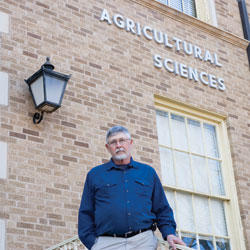Sustainability on the South Plains
Story and Photo by Hardy Elkins
Dwight D. Eisenhower once said farming is easy when your plow is a pencil and you are a thousand miles from the corn field. In essence, the decorated 34th president of the United States was implying that a man must walk in the shoes of the farmer in order to truly understand the challenges of production agriculture.
For more than a decade, Phillip Johnson walked in those shoes with his father through their family’s Friona, Texas corn field. Twenty years later Johnson has replaced his plow with a pencil, but he is still standing in the middle of the field ready to take on one of the greatest challenges of all: the conservation of water in the South Plains.
Johnson, Ph.D., grew up in West Texas as the son of a banker who instilled in him a passion for farming. After graduating high school, Johnson attended Texas Tech University where he earned both a bachelor’s and master’s degree in agricultural and applied economics. Johnson went to work as an area economist for the Texas Agricultural Cooperative Extension Service in Fort Stockton before returning to Friona to farm with his father throughout the mid 1970’s and 1980’s. In 1990 he returned to Tech after more than a decade of farming to pursue his Ph.D.
Johnson’s interest in finance and the experiences on his own family farm drove him to focus his doctoral research on the Conservation Reserve Program, one of the most noticeable provisions in both the 1985 and 1990 farm bills. Now as a professor and advisor in the department, Johnson has focused his current research on the financial implications of conservation policies on different levels of the farming economy in the Texas High Plains.
In September of 2004, the Texas Water Development Board funded a project titled the Texas Alliance for Water Conservation. The eight-year project, which was spearheaded at Tech by Vivien Allen, Ph.D., and Eduardo Segarra, Ph.D., was created in response to the need to study and demonstrate water conservation methods to meet the water planning goals that the Texas legistlature implemented. Johnson was asked to join the project and with the help of Jeff Johnson, Ph.D., a former graduate student of his and current Associate Director of the CASNR Water Center, the team moved forward with its modeling research.
“Dr. Eduardo Segarra was a major advisor to me and my early water modeling research,” Johnson said. “But it’s definitely a departmental effort and not one person is really more important than the next. I am just one of many people involved.”
Segarra said Johnson’s background in production agriculture, his experience in the region and his knowledge in the field of finance made him a perfect fit for the project.
“If there was ever anybody that was poised to truly be objective about an issue such as the availability of water in this region it would be Dr. Johnson,” Segarra said.
The project analyzes the economic impact of different conservation and management policies on both the county level and individual farm levels. The water policy team, which includes former doctoral students Justin Weinheimer, Ph.D., Erin Wheeler-Cook, Ph.D., and many other individuals, accounts for these policies in their policy models and analyzes different possible options to reduce depletion of the aquifer while maintaining the highest possible profitability for the farmer.
“This project would not be where it is without the help of Erin and Justin,” said Johnson, “They actually go out and do the work and they deserve a lot of the credit.”
Johnson said the reality of restricting water usage by farmers in the region is inevitable one way or the other.
“Mother Nature will restrict water availability eventually,” Johnson said. “Whether by restriction from nature or by implementation of policy, this is a reality we will face in
the future.”
Not only does the study analyze the financial impact of a policy, it also examines how the policy affects water levels in the aquifer in different regions.
Weinheimer’s dissertation research, which became a critical aspect of the project, incorporates a two-step approach to interpret how an individual farmer’s response decisions to possible policies impacts their farm financially. Some of the variables considered in the study included more efficient crop selection, adopting dryland farming techniques and modified irrigation scheduling in order to yield the most profitable crop per acre.
Johnson said the most common water policy being considered by agencies in the region is known as the 50/50 policy. In short, the policy states that at least 50 percent of the current underground saturated thickness below the surface must still be present 50 years from now.
In order to help farmers prepare to adapt to such a policy, the team is continuing to study the best way to allocate water to meet conservation requirements and maintain economic viability.
“Ultimately, it is the farmer who has to adapt to whatever policy is put in place,” Johnson said. “We are just trying to put the tools together to assist the producers.”
The significance of the research will be even greater in the southern counties of the Texas High Plains where water levels in the Ogallala Aquifer are lower. Now more than ever, farmer’s will need to utilize their water resource as efficiently as possible.
“Anytime you restrict a resource like water it is going to have an impact on profitability,” Johnson said. “Sustainability is ultimately the most important goal to us.”